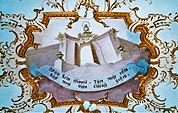Pearly gates

Pearly gates is an informal name for the gateway to Heaven according to some Christian denominations. It is inspired by the description of the New Jerusalem in Revelation 21:21: "The twelve gates were twelve pearls, each gate made of a single pearl."[1]
The image of the gates in popular culture is a set of large gold, white, or wrought-iron gates in the clouds, guarded by Saint Peter (the keeper of the "keys to the kingdom"). Those not fit to enter heaven are denied entrance at the gates, and descend into Hell.[2] In some versions of this imagery, Peter looks up the deceased's name in a book, before opening the gate.
The pearly gates provide the background for a joke cycle: "the premise of these jokes is that admission is not automatic but that the criteria for admission are somewhat arbitrary."[3]
References
[edit]- ^ Lang, J. Stephen (2003). "59: Imagine the Size of Those Oysters". What the Good Book Didn't Say: Popular Myths and Misconceptions About the Bible. Citadel Press. p. 185. ISBN 9780806524603.
- ^ Ferguson, Everett (1996). The Church of Christ: A Biblical Ecclesiology for Today. Wm. B. Eerdmans Publishing. p. 53. ISBN 9780802841896.
The passage moves from a building, to gates, to keys. A popular image has Peter as the doorkeeper of heaven, deciding admission through the pearly gates to each person at death. This understanding of Peter goes back to an early medieval interpretation that identified Peter with a figure in Germanic mythology who was the porter of heaven.
- ^ Capps, Donald (2006). A Time to Laugh: The Religion of Humor. A&C Black. p. 30. ISBN 9780826418579. Retrieved 14 July 2022.


